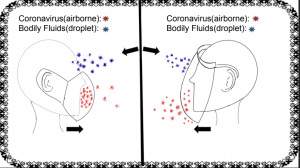The Right Protection During a Pandemic
January 7, 2021
In the midst of this pandemic it is important to keep everyone safe. Just wearing any ‘protective’ device isn’t going to cut it anymore.
According to the Center for Disease Control (CDC) COVID-19 is spread through contact transmission, droplet transmission, and airborne transmission. Today, we will be mainly focused on the difference between droplet and airborne transmission.
Droplet transmission can occur when a person comes in contact with an infected person and they are closer than six feet. The droplets can vary from visible secretions to invisible particles; these are exhaled from the infected person’s body and can travel to the other person in a very concentrated dose of COVID-19.

Airborne transmission is when smaller droplets travel through the air long distances (typically longer than six feet). These droplets can travel over six feet; however, the further you are from the source, the greater the droplets are spread out, therefore the less droplets you would inhale when you breathe.
Face shields are made to protect from droplet transmission rather than airborne transmission. Best said by registered nurse Samantha Hammond, “Face shields are meant for blocking projectile body fluids”.
Unlike face shields, the proper face masks protect against airborne viruses.
According to the CDC to stay safe you must, “Wear masks with two or more layers to stop the spread of COVID-19”. Face masks without two or more layers are practically useless. If you wear gaiters it is recommended to fold it over to make it so there are two layers.
Clearly, face shields are not as effective (if effective at all) as surgical or N95 masks. That being said, please do not buy out all of the N95 and surgical masks. These masks must be saved and reserved for healthcare professionals.
Since the N95 and surgical masks work well, they should be reserved mostly for healthcare professionals! They are the ones that are at the highest risk, and if nurses and doctors all start getting sick we’re going to have an even bigger problem.
The best bet for normal, everyday folks are homemade or cloth reusable masks, which should be washed after each use. But, again, these masks must have at least two layers!
Thus far I have talked about what mask you should wear, but why wear a mask at all if you don’t show symptoms? Well, some viruses affect people in different ways. COVID-19 is one of those viruses.
Some people get so sick they have to be hospitalized, some are hardly affected, and some show no symptoms at all. When you show no symptoms of a virus it is called asymptomatic. UChealth states, “Studies show that at least 40-to-50% of people who test positive for COVID-19 have no symptoms.” So, while you may not feel bad, you can still spread the virus to others.
There are also times before you show symptoms that you can spread COVID-19. This is called pre-symptomatic. The CDC informs that people can spread COVID-19 up to 48 hours before ever showing symptoms.
Part of the reason COVID-19 is being spread so quickly is because of asymptomatic and pre-symptomatic people unknowingly spreading the virus everywhere. This is why you must always wear a mask in public areas. Not just any mask, though; make sure it has at least two layers.
If we are ever going to get through this pandemic, we must wear real protective devices that are proven to work. Not things that may or may not work like face shields. If you wear a face shield, please consider wearing a mask with a clear cut out around the mouth. This will be much more effective.

